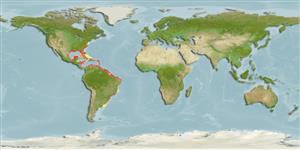Environment: milieu / climate zone / depth range / distribution range
Ökologie
seewasser; brackwasser demersal; tiefenbereich ? - 55 m (Ref. 26912). Tropical; 20°C - 25°C (Ref. 36323)
Western Atlantic: southern Caribbean to Brazil. Record from the Virgin Islands needs verification.
Size / Gewicht / Alter
Maturity: Lm ? range ? - ? cm
Max length : 26.0 cm TL Männchen/unbestimmt; (Ref. 5217); common length : 20.0 cm TL Männchen/unbestimmt; (Ref. 5217); max. veröff. Gewicht: 199.20 g (Ref. 131022)
Rückenflossenstacheln (insgesamt) : 10; Rückenflossenweichstrahlen (insgesamt) : 12 - 14; Afterflossenstacheln: 3; Afterflossenweichstrahlen: 7. Body dusky green with 2 longitudinal dark stripes; cheeks yellowish olive with diagonal blue stripes; fins dusky; anal and caudal fins with a tinge of yellow (Ref. 13608). Preopercle with a single prominent group of spines at the angle; 3 flat spines on posterior part of opercle. Soft portions of dorsal and anal fin bases without scales. Pectoral fin longer than pelvic fin. Caudal fin with no elongated ray (Ref. 36323).
Occurs commonly in coastal waters and also enter estuarine regions (Ref. 36323). Found over soft bottoms. Flesh is of good quality and is eaten fresh.
Life cycle and mating behavior
Geschlechtsreife | Fortpflanzung | Ablaichen | Eier | Fecundity | Larven
Indeterminate fecundity with asynchronous ovarian organization (Ref. 115898).
Cervigón, F., R. Cipriani, W. Fischer, L. Garibaldi, M. Hendrickx, A.J. Lemus, R. Márquez, J.M. Poutiers, G. Robaina and B. Rodriguez, 1992. Fichas FAO de identificación de especies para los fines de la pesca. Guía de campo de las especies comerciales marinas y de aquas salobres de la costa septentrional de Sur América. FAO, Rome. 513 p. Preparado con el financiamento de la Comisión de Comunidades Europeas y de NORAD. (Ref. 5217)
IUCN Rote Liste Status (Ref. 130435: Version 2024-1)
Bedrohung für Menschen
Harmless
Nutzung durch Menschen
Fischereien: weniger kommerziell
Tools
Zusatzinformationen
Download XML
Internet Quellen
Estimates based on models
Preferred temperature (Ref.
123201): 22.7 - 27.9, mean 25.6 °C (based on 430 cells).
Phylogenetic diversity index (Ref.
82804): PD
50 = 0.5002 [Uniqueness, from 0.5 = low to 2.0 = high].
Bayesian length-weight: a=0.00631 (0.00451 - 0.00883), b=3.14 (3.04 - 3.24), in cm total length, based on LWR estimates for this species (Ref.
93245).
Trophic level (Ref.
69278): 4.1 ±0.68 se; based on food items.
Widerstandsfähigkeit (Ref.
120179): mittel, Verdopplung der Population dauert 1,4 - 4,4 Jahre. (Preliminary K or Fecundity.).
Fishing Vulnerability (Ref.
59153): Low vulnerability (16 of 100).
Nutrients (Ref.
124155): Calcium = 183 [78, 350] mg/100g; Iron = 0.97 [0.53, 1.79] mg/100g; Protein = 17.6 [15.8, 19.3] %; Omega3 = 0.188 [0.099, 0.368] g/100g; Selenium = 46.9 [23.7, 93.7] μg/100g; VitaminA = 30.5 [11.6, 96.1] μg/100g; Zinc = 1.39 [0.96, 1.98] mg/100g (wet weight);
